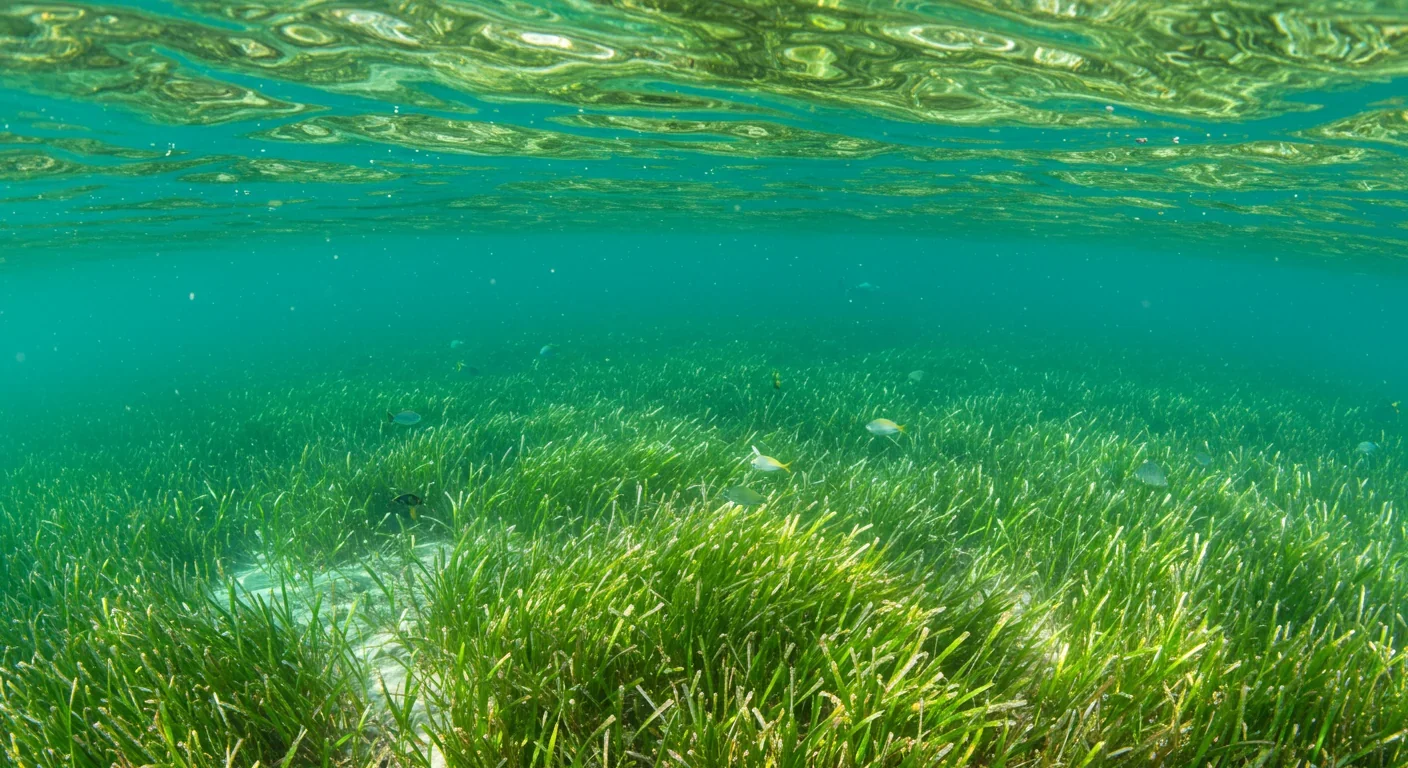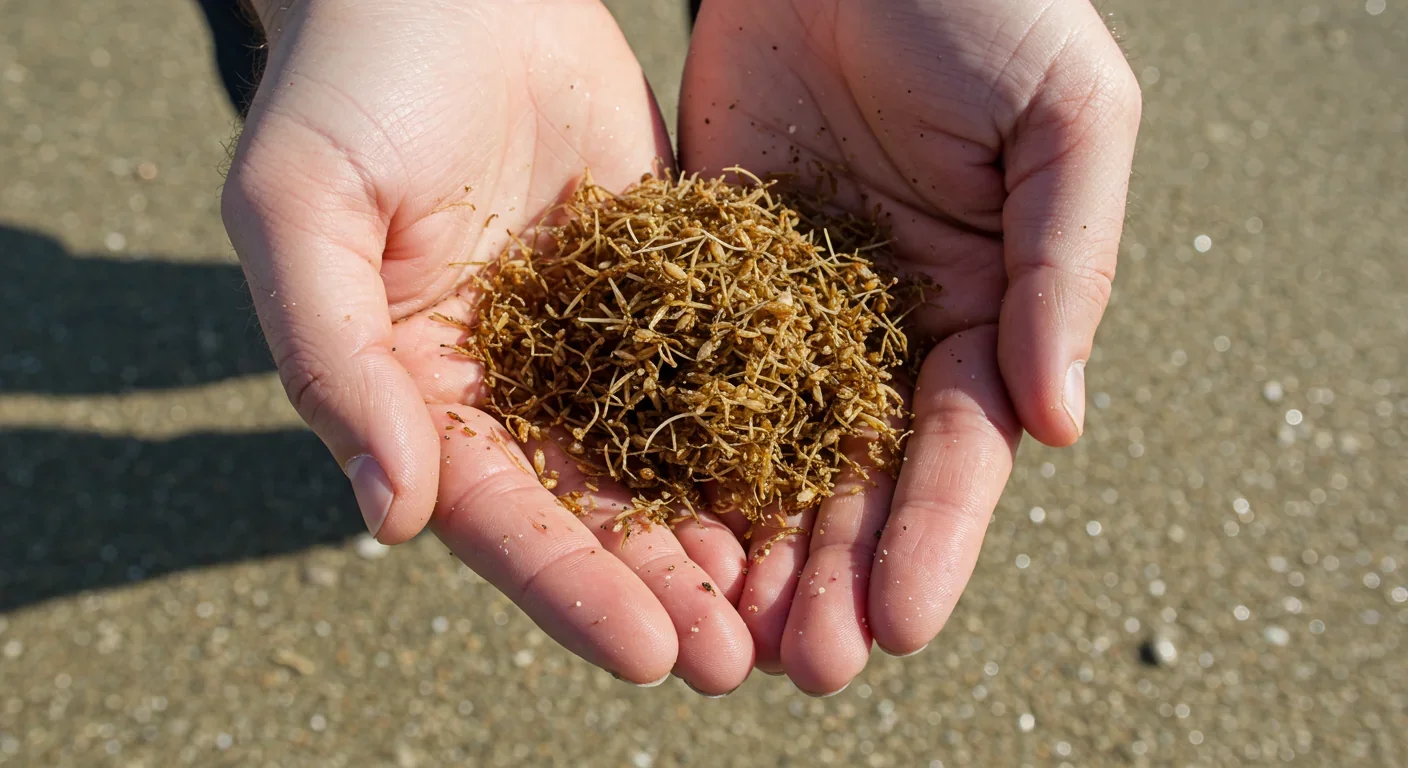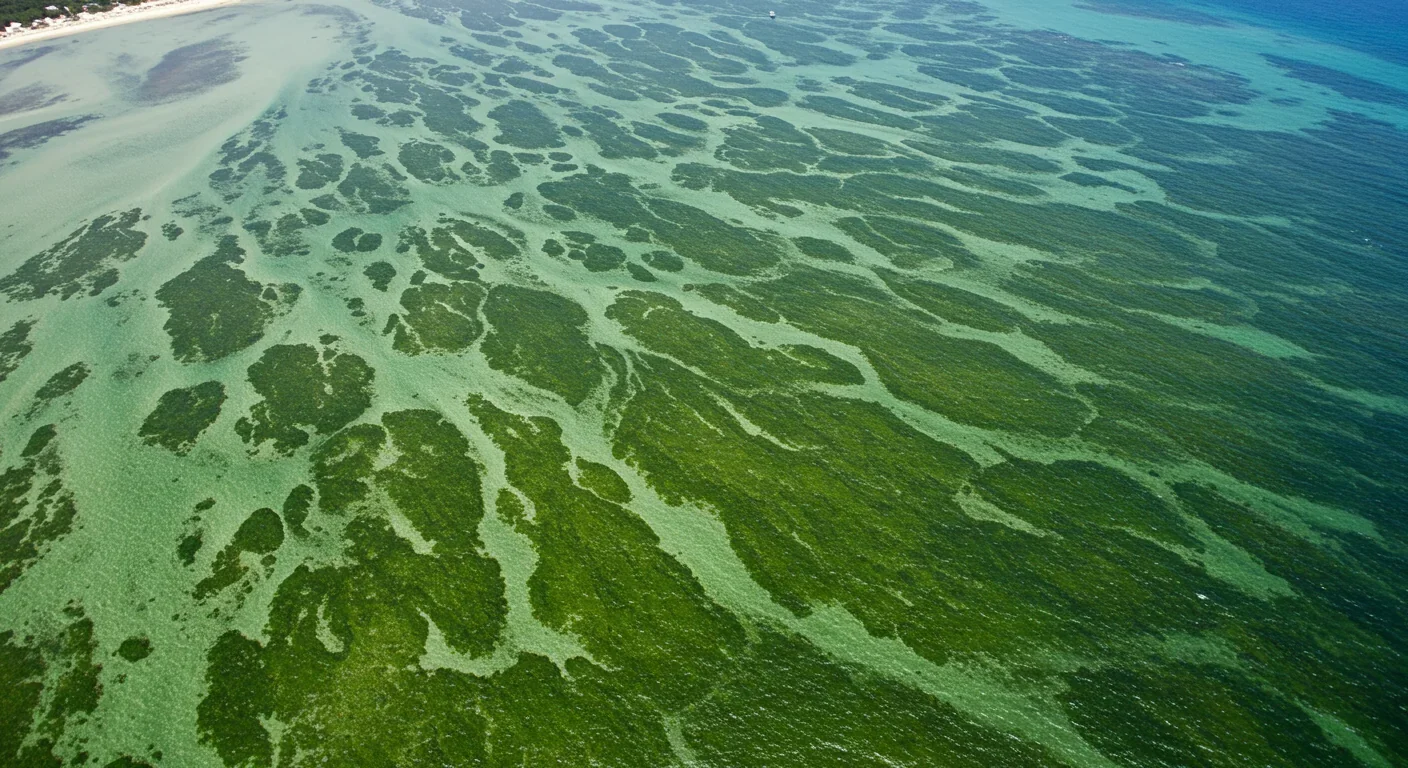Forest Biological Clocks: Ecosystems That Keep Time

TL;DR: Scientists are resurrecting vanished seagrass meadows using ancient dormant seeds buried in ocean sediments. Virginia's pioneering project turned 70 million seeds into 10,500 acres of thriving habitat over two decades.

Beneath the sandy floors of coastal waters, millions of dormant seeds wait in darkness. Some have been buried for years, storing life inside hard shells no bigger than grains of rice. Scientists are now learning to wake these seeds and bring vanished underwater forests back from extinction.
Seagrass meadows once covered vast stretches of coastline, but 30% have disappeared since the 1980s. Traditional restoration meant transplanting shoots by hand—expensive, slow, and limited in scale. The new approach taps into nature's own backup system: seed banks hidden in marine sediments that can resurrect entire ecosystems.
Seagrasses flower once yearly, releasing seeds that drift with currents before sinking into sediment. Unlike most marine plants, these seeds don't die quickly. They wait. Some species form seed banks with hard outer coats that can remain viable for months or even years, depending on conditions.
Research in the German Wadden Sea found seed densities reaching 487 seeds per square meter, with these banks persisting for roughly three years. In Australia's Swan-Canning Estuary, scientists discovered seed banks containing up to 43,590 seeds per square meter immediately after flowering season.
What determines how long seeds survive? It depends on the species and environmental conditions like salinity and temperature. Short-lived species like Halophila and Halodule produce small seeds designed for quick germination. Long-lived species like Posidonia oceanica create larger seeds packed with nutrients to support growth through the first year.

The dormancy isn't indefinite, though. Research shows that seed viability drops significantly when exposed to freshwater—more than half of Halophila ovalis seeds became non-viable after just one week at low salinity. This means extreme rainfall events could flush out natural seed banks before they germinate.
Getting seeds to sprout requires the right combination of signals. Temperature between 15°C and 30°C works best, along with moderate light levels. But there's more to it than just warmth and brightness.
Scientists studying seed bank dynamics found that density peaks right after the reproductive season, then declines through winter and spring. This natural timing tells restoration teams when to collect seeds or stimulate germination. In the Swan-Canning study, germination rates reached 70-80% for seeds with intact coats after one month of proper conditions.
High-nutrient coastal sites can produce over 300 seeds per square meter, while nutrient-poor areas generate fewer than 80—a fourfold difference that dramatically affects restoration potential.
Interestingly, nutrient levels also affect seed production. High-nutrient sites can produce over 300 seeds per square meter, while low-nutrient areas generate fewer than 80. This suggests that careful, monitored nutrient addition might boost restoration success, though excessive nutrients cause the algae blooms that kill seagrass in the first place.
In Virginia's coastal waters, one of the most successful seed-based restoration projects began in 1999. Scientists distributed 70 million eelgrass seeds across bare seafloor. Two decades later, that initial seeding expanded to 10,500 acres of thriving meadow—roughly 17 square miles of recovered habitat.

The UK's Seagrass Ocean Rescue project took a different approach in Dale, Wales. Volunteers filled biodegradable hessian bags with seeds mixed in sterile sand, then divers placed them on the seafloor. The bags anchored seeds in place while allowing shoots to emerge naturally.
England's REMEDIES project, the country's largest seagrass restoration effort, planted 8 hectares of Zostera marina—equivalent to 11 football fields. The team used multiple techniques, including a spring-loaded device called the HMS OCToPUS that injects seeds directly into sediment. One diver with one device can plant 2,000 seeds in under 20 minutes.
"One OCToPUS unit can be used to inject 2,000 seagrass seeds in under 20 minutes, in just one dive, by one diver."
— Blue Meadows Restoration Project
Not all regions have adopted seed-based methods equally. In Australia and New Zealand, restoration projects have focused mainly on transplanting shoots, with seed techniques still largely experimental for species like Posidonia australis and Zostera muelleri.
Modern restoration combines technology with ecological understanding. The National Seagrass Nursery can grow 7,200 plants annually, with plans to double capacity to 14,400. These nursery-grown seedlings get planted on biodegradable mats that dissolve after the roots establish.
For assessing seed quality, X-ray imaging provides a non-destructive way to distinguish viable seeds from dead ones. Scientists can examine thousands of seeds without damaging them, identifying which have intact coats and stored nutrients. Researchers suggest that deep learning algorithms could automate this screening, making large-scale seed bank mapping feasible.

Hydro Marine Seeding (HMS) adapts land-based hydroseeding for underwater environments. The OCToPUS injector uses compressed air to shoot seeds into sediment at precise depths and spacing. This overcomes two major obstacles: seed scarcity (you can deploy seeds wherever you want them) and low natural germination rates (placing seeds at optimal depth improves their chances).
Some projects combine approaches. Seagrass Mat Technology transplants nursery-grown seedlings while HMS devices scatter seeds in between. This hybrid strategy provides immediate coverage from established plants while allowing natural seed recruitment to fill gaps.
Seagrass ecosystems punch far above their weight in ecological value. Though they cover only 0.2% of the ocean floor, they capture up to 10% of oceanic carbon annually. That's because their dense root systems trap sediment and organic matter, burying carbon for centuries.
Seagrass meadows cover just 0.2% of the seafloor but store up to 10% of the ocean's carbon annually—a sequestration rate that rivals tropical rainforests.
The meadows also function as nurseries for commercial fish species, support populations of seahorses, turtles, and dugongs, and stabilize coastlines against erosion. When seagrass disappears, these services vanish too. Global losses total roughly 110 square kilometers per year, adding up to more than 2,200 square kilometers over two decades.
Restoration offers a way to reverse this decline. But speed matters. The longer a site remains bare, the more sediment conditions change, potentially making recolonization harder. Seed-based methods can cover large areas relatively quickly compared to hand-transplanting individual shoots.

The carbon storage potential is substantial. Restored meadows begin sequestering carbon as soon as plants establish and start trapping sediment. While we don't yet know exactly how quickly resurrected meadows match the performance of old-growth beds, the Virginia project's multi-decade success suggests they can develop robust ecosystem functions.
Despite successes, seed-based restoration faces real challenges. Seed banks have relatively short persistence—around three years for species like Zostera noltii—which means restoration may require repeated seeding rather than one-time interventions. Natural recruitment from these banks happens each year, with 20% of new shoots coming from germinated seeds in some populations.
Scaling remains difficult. Blue Meadows aims to restore 50 hectares over 10 years and build capacity for 50 hectares annually afterward. That's impressive for a single organization but tiny compared to the scale of global loss. The Virginia project's success took two decades and covered about 4,250 hectares—significant, but that's one site.
Cost data is frustratingly sparse. No published studies directly compare per-hectare costs of seed-based versus shoot-transplant restoration. Intuitively, scattering seeds should be cheaper than hand-planting thousands of shoots, but germination success and long-term establishment rates vary widely by site. The HMS OCToPUS can work rapidly, but what's the actual cost per hectare including seed collection, diver labor, and monitoring?
"Seed banks in marine sediments exhibit a relatively short-term yet persistent nature (approximately 3 years), which may require continual seeding initiatives rather than a one-time restoration effort."
— German Wadden Sea Research Study
Water quality poses another barrier. If pollution or sedimentation killed the original meadow, seeds won't survive either without addressing root causes. The salinity sensitivity discovered in Australian studies highlights how changing rainfall patterns and freshwater flooding could doom restoration efforts in estuaries.
There's also the question of seed availability. Not all species produce abundant seeds. Seagrasses flower only once per year, and poor germination rates mean you need massive quantities. Establishing nurseries helps, but at 7,200 to 14,400 plants annually, it would take decades to supply seeds for large-scale restoration across multiple sites.
Despite obstacles, the momentum is building. Community engagement and citizen science are expanding restoration capacity. Volunteer divers can deploy seed bags or monitor recovery, multiplying what scientists can accomplish alone.
Technological advances are accelerating progress. Ulysses Ecosystem Engineering is developing underwater robots to automate seed dispersal, potentially covering areas that would take human divers weeks. Automated X-ray screening and deep learning for seed assessment could enable rapid mapping of natural seed banks, identifying the best sites for activation-based restoration.
Research continues to refine techniques. The discovery that moderate nutrient increases boost seed production suggests careful manipulation might jumpstart recovery, though the line between helpful and harmful nutrient loading is thin. Understanding seasonal dynamics helps time interventions—collecting seeds post-flowering when banks are fullest, or triggering germination when conditions are optimal.
International cooperation is spreading knowledge. Projects in the UK, US, Germany, and Australia are producing data that benefits everyone. Techniques developed for Zostera marina in Virginia can inform efforts with other species elsewhere. The fact that seed-based methods remain experimental in Australia and New Zealand represents an opportunity to transfer successful approaches from other regions.
The elegance of seed bank restoration lies in its simplicity: we're not inventing a new solution but rediscovering one that seagrasses engineered millions of years ago. These plants evolved seed dormancy as insurance against disturbance. Now, as ocean conditions shift and human impacts accelerate, that ancient adaptation offers us a tool to undo some of the damage.
A 30% decline in three decades is devastating, but it's not irreversible. Virginia's 10,500-acre meadow proves that with the right approach, lost seagrass can return—and bring its ecosystem services back with it.
The seeds waiting in darkness represent possibility. Each one is a compressed meadow, a carbon sink, a fish nursery, a storm buffer. The question is whether we'll deploy the resources and ingenuity to wake them up at scale. The technology exists. The knowledge is accumulating. What's needed now is the commitment to turn isolated successes into a global restoration movement.
Beneath the waves, in the muddy sediments of our coastlines, ancient seeds are waiting. They've always been there, patient and persistent. We just needed to learn how to ask them for help.

MOND proposes gravity changes at low accelerations, explaining galaxy rotation without dark matter. While it predicts thousands of galaxies correctly, it struggles with clusters and cosmology, keeping the dark matter debate alive.

Ultrafine pollution particles smaller than 100 nanometers can bypass the blood-brain barrier through the olfactory nerve and bloodstream, depositing in brain tissue where they trigger neuroinflammation linked to dementia and neurological disorders, yet remain completely unregulated by current air quality standards.

CAES stores excess renewable energy by compressing air in underground caverns, then releases it through turbines during peak demand. New advanced adiabatic systems achieve 70%+ efficiency, making this decades-old technology suddenly competitive for long-duration grid storage.

Our brains are hardwired to see patterns in randomness, causing the gambler's fallacy—the mistaken belief that past random events influence future probabilities. This cognitive bias costs people millions in casinos, investments, and daily decisions.

Forests operate as synchronized living systems with molecular clocks that coordinate metabolism from individual cells to entire ecosystems, creating rhythmic patterns that affect global carbon cycles and climate feedback loops.

Generation Z is the first cohort to come of age amid a polycrisis - interconnected global failures spanning climate, economy, democracy, and health. This cascading reality is fundamentally reshaping how young people think, plan their lives, and organize for change.

Zero-trust security eliminates implicit network trust by requiring continuous verification of every access request. Organizations are rapidly adopting this architecture to address cloud computing, remote work, and sophisticated threats that rendered perimeter defenses obsolete.